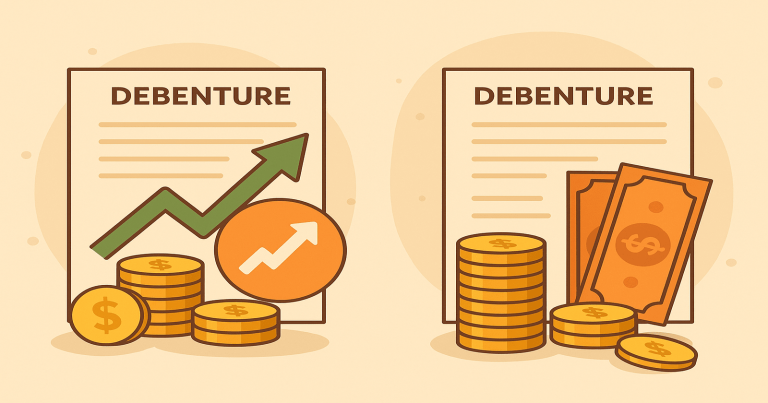The difference between convertible and non-convertible debentures can be seen in the features and benefits of each. Convertible debentures provide investors with the facility to convert into equity shares after a specified period, presenting a mix of fixed returns and potential ownership benefits. Non-convertible debentures, often abbreviated as NCDs, focus purely on providing fixed returns, and hence, present investors with stable income, but not with any equity conversion features. Two types of debentures are issued through corporate fundraising, both catering to different needs and preferences of investors.
What are Convertible Debentures?
Convertible debentures are convertible instruments issued by corporations to the public that can be exchanged into equity shares after a certain period or on specified terms. These debentures carry the characteristics of debt and equity, offering fixed-interest payments with the opportunity for capital appreciation through shareholding.
Key Features of Convertible Debentures
- Option to convert: Convertible debentures provide the option to be converted into equity, which implies growth for investors.
- Lower Interest Rates: Convertible debentures normally carry lower interest than most other debt instruments because they offer the extra advantage of convertibility.
- Dual Nature: Up to conversion, they behave like straight debt securities, yielding fixed interest. After conversion, they behave like shares of equity.
Types of Convertible Debentures
- Fully Convertible Debentures (FCDs): Entirely converted into equity at a predetermined ratio and time.
- Partially Convertible Debentures (PCDs): Only a part of the debenture converts into equity, while the remaining portion continues as debt.
- Optionally Convertible Debentures (OCDs): Conversion is left to the discretion of the debenture holder.
What are Non-Convertible Debentures?
Non-convertible debentures (NCDs) are fixed-income instruments that are not to be converted into equity shares. NCDs have been primarily designed for achieving consistent interest incomes and are used by companies on many occasions to raise funds for specific projects or operational needs.
Key Features of Non-Convertible Debentures
- Fixed Maturity Period: NCDs come with a defined tenure after which the principal is repaid.
- Higher Interest Rates: They offer higher interest rates compared to convertible debentures, compensating for the lack of a conversion option.
- No Conversion Feature: Investors remain debt holders throughout the tenure, with no equity benefits.
- Security: NCDs can be secured (backed by assets) or unsecured, impacting their risk profile.
Types of Non-Convertible Debentures
- Secured NCDs: Backed by company assets, reducing risk for investors.
- Unsecured NCDs: Not backed by assets, offering higher returns but with increased risk.

Key Differences Between Convertible & Non-Convertible Debentures
Here are five detailed differences between convertible and non-convertible debentures to help understand their distinct features and appeal:
Conversion Option
- Convertible Debentures: They are issued with an option to convert into equity shares after certain periods or under certain terms. This enables the investor to switch over from debt holders to shareholders, enabling them to benefit from capital appreciation.
- Non-Convertible Debentures: This has no conversion feature. The investors will remain as debt holders for the complete tenure and receive fixed interest payments without any equity benefits.
Returns
- Convertible Debentures: These offer dual returns fixed interest during the debenture period and the potential for capital gains after conversion to equity. However, the interest rate is typically lower to account for the conversion benefit.
- Non-Convertible Debentures: NCDs provide higher fixed interest rates throughout their tenure, making them ideal for investors seeking a steady income without exposure to market fluctuations.
Risk Profile
- Convertible Debentures: While convertible debentures offer growth potential, they come with higher risks due to their dependence on stock market performance post-conversion. If the company’s equity performs poorly, the investor’s value diminishes.
- Non-Convertible Debentures: NCDs are relatively lower in risk concerning market fluctuations but can carry credit risk, especially if unsecured. Investors rely on the company’s ability to meet its debt obligations.
Investor Appeal
- Convertible Debentures: These are attractive to those investors who want a steady return but at the same time also expect growth opportunities. They are best for risk-takers with an interest in equity markets. Example: A young investor wanting to capitalize on potential growth along with some stability of income may prefer convertible debentures.
- Non-Convertible Debentures: These are more attractive to conservative investors who focus more on stable and predictable income rather than going for equity participation. Example: A retiree looking for fixed monthly income would be serviced much better through NCDs because of higher interest rates and fixed returns.
Impact on Issuers
- Convertible Debentures: For companies, issuing convertible debentures is advantageous as it allows borrowing at lower interest rates. However, the conversion results in a dilution of equity, which may affect existing shareholders.
- Non-Convertible Debentures: Issuing NCDs requires companies to pay higher interest rates, increasing borrowing costs. However, they do not dilute equity, making them preferable for companies that wish to retain shareholder value.
| Aspect | Convertible Debentures | Non-Convertible Debentures (NCDs) |
| Conversion Option | Convertible to equity shares, offering capital appreciation potential. | No conversion; remains as fixed debt with interest payments. |
| Returns | Dual returns: lower fixed interest + potential capital gains post-conversion. | Higher fixed interest rates; steady income without equity benefits. |
| Risk Profile | Higher risk post-conversion due to market performance. | Lower market risk but carries credit risk (if unsecured). |
| Investor Appeal | Suitable for growth-oriented, risk-tolerant investors (e.g., young investors). | Ideal for conservative, income-focused investors (e.g., retirees). |
| Impact on Issuers | Lower borrowing cost but dilutes equity upon conversion. | Higher interest cost but retains shareholder equity. |
Convertible vs Non Convertible Debentures FAQs
What are convertible debentures?
Convertible debentures are debt securities that, after a specific period, can be converted into equity shares with the advantages of delivering a fixed income and growth possibility.
What is a non-convertible debenture?
Non-convertible debentures (NCDs) are debt instruments that cannot be converted into equities and give more fixed returns to the investors.
Which of the two is riskier: convertible or non-convertible?
Convertible debentures have market risk as their equity content while NCDs carry credit risk especially when unsecured.
Why do companies issue convertible debentures?
Companies issue convertible debentures to raise funds at relatively low rates of interest besides offering the investor the potential of equity ownership.
Who should invest in non-convertible debentures?
NCD is meant for conservative investors seeking stable and higher fixed income without the feeling of any exposure to stock market fluctuations.


